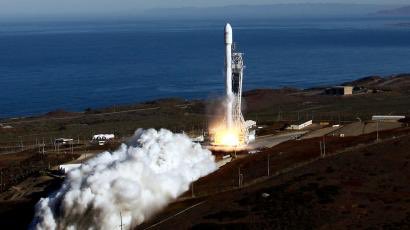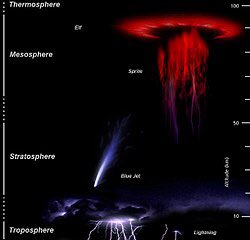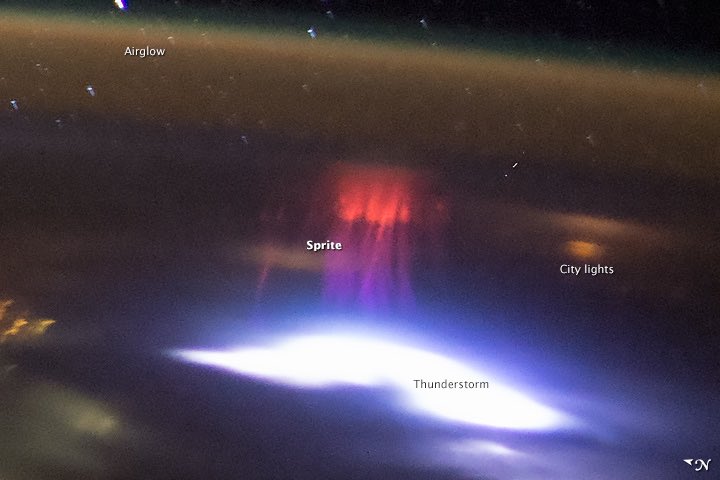I’m seriously tempted to dive into the physics of this. Very cool! https://twitter.com/SPACEdotcom/status/1133100574256164865">https://twitter.com/SPACEdotc...
I’m not sure how to organize this (Twitter is my perpetual rough draft), so pls hop in with questions & extensions.
tl;dr:
Why did lightning strike a rocket, what exactly happened, how come it didn’t cause damage, and why is this cool?
tl;dr:
Why did lightning strike a rocket, what exactly happened, how come it didn’t cause damage, and why is this cool?
Lightning + rockets probably sound like a bad combo. They are! But... they’re also tightly linked.  https://abs.twimg.com/emoji/v2/... draggable="false" alt="🌩" title="Cloud with lightning" aria-label="Emoji: Cloud with lightning">
https://abs.twimg.com/emoji/v2/... draggable="false" alt="🌩" title="Cloud with lightning" aria-label="Emoji: Cloud with lightning"> https://abs.twimg.com/emoji/v2/... draggable="false" alt="🚀" title="Rocket" aria-label="Emoji: Rocket">
https://abs.twimg.com/emoji/v2/... draggable="false" alt="🚀" title="Rocket" aria-label="Emoji: Rocket"> https://abs.twimg.com/emoji/v2/... draggable="false" alt="⚡️" title="High voltage sign" aria-label="Emoji: High voltage sign">
https://abs.twimg.com/emoji/v2/... draggable="false" alt="⚡️" title="High voltage sign" aria-label="Emoji: High voltage sign">
Launching from coasts nearer the equator often means thunderstorms (hi Florida), rockets are big metal lightning rods (whoops).
So we make plans.
Launching from coasts nearer the equator often means thunderstorms (hi Florida), rockets are big metal lightning rods (whoops).
So we make plans.
The launch pads in Cape Canaveral have 4 corner lightning rod towers to protect spacecraft. They’re wired together, creating a Faraday cage: a metal screen that protects the rocket from stray currents.
 https://abs.twimg.com/emoji/v2/... draggable="false" alt="📷" title="Camera" aria-label="Emoji: Camera">Lightning strike while Challenger was on the pad for STS-8. Sam Walton
https://abs.twimg.com/emoji/v2/... draggable="false" alt="📷" title="Camera" aria-label="Emoji: Camera">Lightning strike while Challenger was on the pad for STS-8. Sam Walton
But rockets are no fun on the ground. If you wanna get to space, you gotta blast through the atmosphere.
And that’s where the real problems begin: rockets trigger lightning.
And that’s where the real problems begin: rockets trigger lightning.
The first time we noticed rocket-triggered lightning was with the Saturn V blasting off carrying Apollo 12.
As the rocket penetrated the cloud layer, it triggered 2 strikes. Eek! But the spacecraft was fine (& successfully completed the 2nd moon landing), so... scary but ok.
As the rocket penetrated the cloud layer, it triggered 2 strikes. Eek! But the spacecraft was fine (& successfully completed the 2nd moon landing), so... scary but ok.
Rules changed, launches started getting scrubbed for weather, blah blah blah.
But then in 1986, a Delta 3194 carrying a GOES weather satellite was struck by lightning 71s after launch. It fried.
Badly.
Like engine-shutdown & a triggered self-destruct badly.
But then in 1986, a Delta 3194 carrying a GOES weather satellite was struck by lightning 71s after launch. It fried.
Badly.
Like engine-shutdown & a triggered self-destruct badly.
Ditto the next year when lightning nailed an Atlas-Centaur rocket carrying a very expensive military satellite 49s after launch, again triggering self-destruct.
So NASA tightened its weather-rules:
https://www.nasa.gov/audience/foreducators/9-12/features/F_Lightning_and_Launches_9_12.html">https://www.nasa.gov/audience/...
So NASA tightened its weather-rules:
https://www.nasa.gov/audience/foreducators/9-12/features/F_Lightning_and_Launches_9_12.html">https://www.nasa.gov/audience/...
Meanwhile, weather researchers embraced maniacal laughter by developing a new experimental technique.
By launching rockets trailing wire behind them, scientists amped up conductivity to study rocket-triggered lightning. Its gorgeous-terrifying.
More: https://www.wired.com/2015/06/the-lightning-machine/">https://www.wired.com/2015/06/t...
By launching rockets trailing wire behind them, scientists amped up conductivity to study rocket-triggered lightning. Its gorgeous-terrifying.
More: https://www.wired.com/2015/06/the-lightning-machine/">https://www.wired.com/2015/06/t...
Lightning happens when charge builds up in the sky.
Simplified, this happens as downdrafted ice & hail strip electrons from updrafted water. Charge builds up with a positive cloud top, negative bottom, until it overcomes & discharges.
More: https://scijinks.gov/lightning/ ">https://scijinks.gov/lightning...
Simplified, this happens as downdrafted ice & hail strip electrons from updrafted water. Charge builds up with a positive cloud top, negative bottom, until it overcomes & discharges.
More: https://scijinks.gov/lightning/ ">https://scijinks.gov/lightning...
Any time we shove metal conductors like planes or rockets through ionized* clouds, those conductors are a perfect discharge path.
Path of least resistance = lightning.
 https://abs.twimg.com/emoji/v2/... draggable="false" alt="⛈" title="Thunder cloud and rain" aria-label="Emoji: Thunder cloud and rain">
https://abs.twimg.com/emoji/v2/... draggable="false" alt="⛈" title="Thunder cloud and rain" aria-label="Emoji: Thunder cloud and rain"> https://abs.twimg.com/emoji/v2/... draggable="false" alt="⚡️" title="High voltage sign" aria-label="Emoji: High voltage sign">
https://abs.twimg.com/emoji/v2/... draggable="false" alt="⚡️" title="High voltage sign" aria-label="Emoji: High voltage sign"> https://abs.twimg.com/emoji/v2/... draggable="false" alt="🚀" title="Rocket" aria-label="Emoji: Rocket">
https://abs.twimg.com/emoji/v2/... draggable="false" alt="🚀" title="Rocket" aria-label="Emoji: Rocket"> https://abs.twimg.com/emoji/v2/... draggable="false" alt="⚡️" title="High voltage sign" aria-label="Emoji: High voltage sign">
https://abs.twimg.com/emoji/v2/... draggable="false" alt="⚡️" title="High voltage sign" aria-label="Emoji: High voltage sign"> https://abs.twimg.com/emoji/v2/... draggable="false" alt="✈️" title="Airplane" aria-label="Emoji: Airplane">
https://abs.twimg.com/emoji/v2/... draggable="false" alt="✈️" title="Airplane" aria-label="Emoji: Airplane"> https://abs.twimg.com/emoji/v2/... draggable="false" alt="⚡️" title="High voltage sign" aria-label="Emoji: High voltage sign">
https://abs.twimg.com/emoji/v2/... draggable="false" alt="⚡️" title="High voltage sign" aria-label="Emoji: High voltage sign"> https://abs.twimg.com/emoji/v2/... draggable="false" alt="⛈" title="Thunder cloud and rain" aria-label="Emoji: Thunder cloud and rain">
https://abs.twimg.com/emoji/v2/... draggable="false" alt="⛈" title="Thunder cloud and rain" aria-label="Emoji: Thunder cloud and rain">
*ionized = charged particles by redistributing electrons
Path of least resistance = lightning.
*ionized = charged particles by redistributing electrons
Airplanes get hit by lightning ALL THE TIME.
It hits an extremity (nose, tail, wingtip), flows along the outer conductive layer (aluminum or composite with conductive fibres), & exits. As long as there’s no gap, it’s all fine.
More: https://www.airspacemag.com/flight-today/how-things-work-lightning-protection-161993347/">https://www.airspacemag.com/flight-to...
It hits an extremity (nose, tail, wingtip), flows along the outer conductive layer (aluminum or composite with conductive fibres), & exits. As long as there’s no gap, it’s all fine.
More: https://www.airspacemag.com/flight-today/how-things-work-lightning-protection-161993347/">https://www.airspacemag.com/flight-to...
You might have been on a plane that was struck by lightning. It happens roughly 1 every 1,000 flight-hours.
The last lightning-induced plane crash was 1967, after which FAA rules tightened to handle surges. Lights might flicker, but otherwise it should be fine.
The last lightning-induced plane crash was 1967, after which FAA rules tightened to handle surges. Lights might flicker, but otherwise it should be fine.
The same basic idea applies to rockets:
Lightning will strike an extremity (nose, tail), flow along the conductive body, & exit. If it has no gaps, it’ll be a Faraday cage protecting its payload. As long as the rocket electronics can handle the surge, it should be fine.
Lightning will strike an extremity (nose, tail), flow along the conductive body, & exit. If it has no gaps, it’ll be a Faraday cage protecting its payload. As long as the rocket electronics can handle the surge, it should be fine.
Key differences between rockets & planes:
Rockets punch vertically through cloud layers, and rockets trail ionized exhaust connecting them to ground.
Both of these make lightning strikes more likely.
And “should be fine” still carries a risk. Thus: weather scrubs.
Rockets punch vertically through cloud layers, and rockets trail ionized exhaust connecting them to ground.
Both of these make lightning strikes more likely.
And “should be fine” still carries a risk. Thus: weather scrubs.
Another reason to have lightning rods on launch pads?
If a rocket is struck, its ionized exhaust trail is going to guide lightning right back to its launch point.
Like we can see from this weekend: https://twitter.com/rogozin/status/1132970813790015489">https://twitter.com/rogozin/s...
If a rocket is struck, its ionized exhaust trail is going to guide lightning right back to its launch point.
Like we can see from this weekend: https://twitter.com/rogozin/status/1132970813790015489">https://twitter.com/rogozin/s...
I keep describing things as Faraday cages, but how exactly do they work?
Any time you have a complete conductive enclosure (metal mesh cage, conductive alloy vehicle), charge carriers (electrons) can move freely along the surface.
ie, zaps are countered
Any time you have a complete conductive enclosure (metal mesh cage, conductive alloy vehicle), charge carriers (electrons) can move freely along the surface.
ie, zaps are countered
But, like ideal frictionless surfaces & imagining spherical cows, real Faraday cages are limited by the messiness of reality.
irl, a Faraday cage greatly attenuates electric fields (see: metal frame buildings with terrible cell reception), but not perfectly block everything.
irl, a Faraday cage greatly attenuates electric fields (see: metal frame buildings with terrible cell reception), but not perfectly block everything.
It’s not shocking (heh) for a rocket to be struck by lightning, and when it happens it should usually be ok.
But it’s still extremely cool,m to see, and a nice engineering triumph when the spacecraft survives.
 https://abs.twimg.com/emoji/v2/... draggable="false" alt="📷" title="Camera" aria-label="Emoji: Camera"> xkcd
https://abs.twimg.com/emoji/v2/... draggable="false" alt="📷" title="Camera" aria-label="Emoji: Camera"> xkcd
But it’s still extremely cool,m to see, and a nice engineering triumph when the spacecraft survives.
Q: Are all launch locations equally at risk?
A: Nope! Vandenberg in southern California rarely gets thunderstorms. They still scrub when fire-generated pyrocumulus clouds violate Lightning Launch Commit Criteria (LLCC), but they don’t even have lightning arrestors on the pads
A: Nope! Vandenberg in southern California rarely gets thunderstorms. They still scrub when fire-generated pyrocumulus clouds violate Lightning Launch Commit Criteria (LLCC), but they don’t even have lightning arrestors on the pads
Q: What about high altitude lightning?
A: Now that’s a Very Interesting Question...
We’re still new at studying lightning in the upper atmosphere (with astronauts & lightning cameras on the space station helping out). So far, we haven’t pulled that out as a distinct risk.
A: Now that’s a Very Interesting Question...
We’re still new at studying lightning in the upper atmosphere (with astronauts & lightning cameras on the space station helping out). So far, we haven’t pulled that out as a distinct risk.
More details on how Apollo 12 survived its lightning strike: https://twitter.com/yellowstoneten/status/1133135056577409024
(Adorable">https://twitter.com/yellowsto... astronaut transcript quotes, redux: “Conrad: The hell was that?”)
(Adorable">https://twitter.com/yellowsto... astronaut transcript quotes, redux: “Conrad: The hell was that?”)

 Read on Twitter
Read on Twitter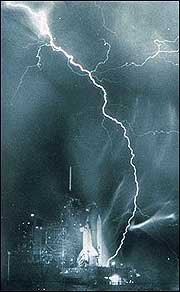 Lightning strike while Challenger was on the pad for STS-8. Sam Walton" title="The launch pads in Cape Canaveral have 4 corner lightning rod towers to protect spacecraft. They’re wired together, creating a Faraday cage: a metal screen that protects the rocket from stray currents.https://abs.twimg.com/emoji/v2/... draggable="false" alt="📷" title="Camera" aria-label="Emoji: Camera">Lightning strike while Challenger was on the pad for STS-8. Sam Walton" class="img-responsive" style="max-width:100%;"/>
Lightning strike while Challenger was on the pad for STS-8. Sam Walton" title="The launch pads in Cape Canaveral have 4 corner lightning rod towers to protect spacecraft. They’re wired together, creating a Faraday cage: a metal screen that protects the rocket from stray currents.https://abs.twimg.com/emoji/v2/... draggable="false" alt="📷" title="Camera" aria-label="Emoji: Camera">Lightning strike while Challenger was on the pad for STS-8. Sam Walton" class="img-responsive" style="max-width:100%;"/>
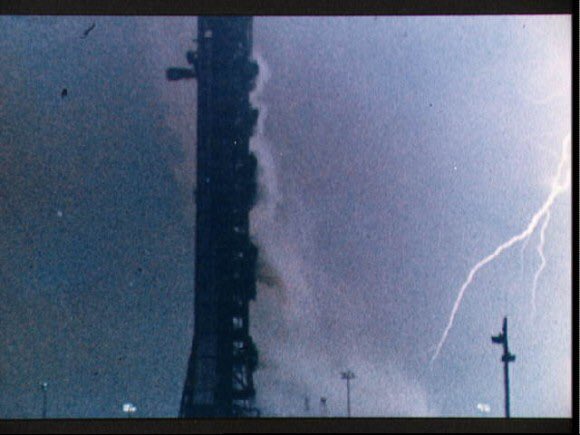
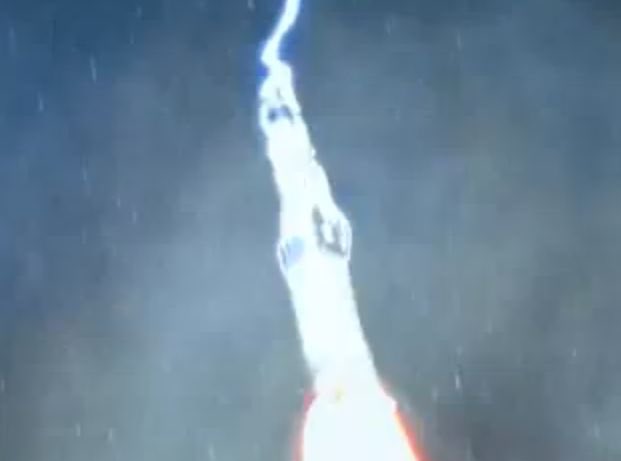
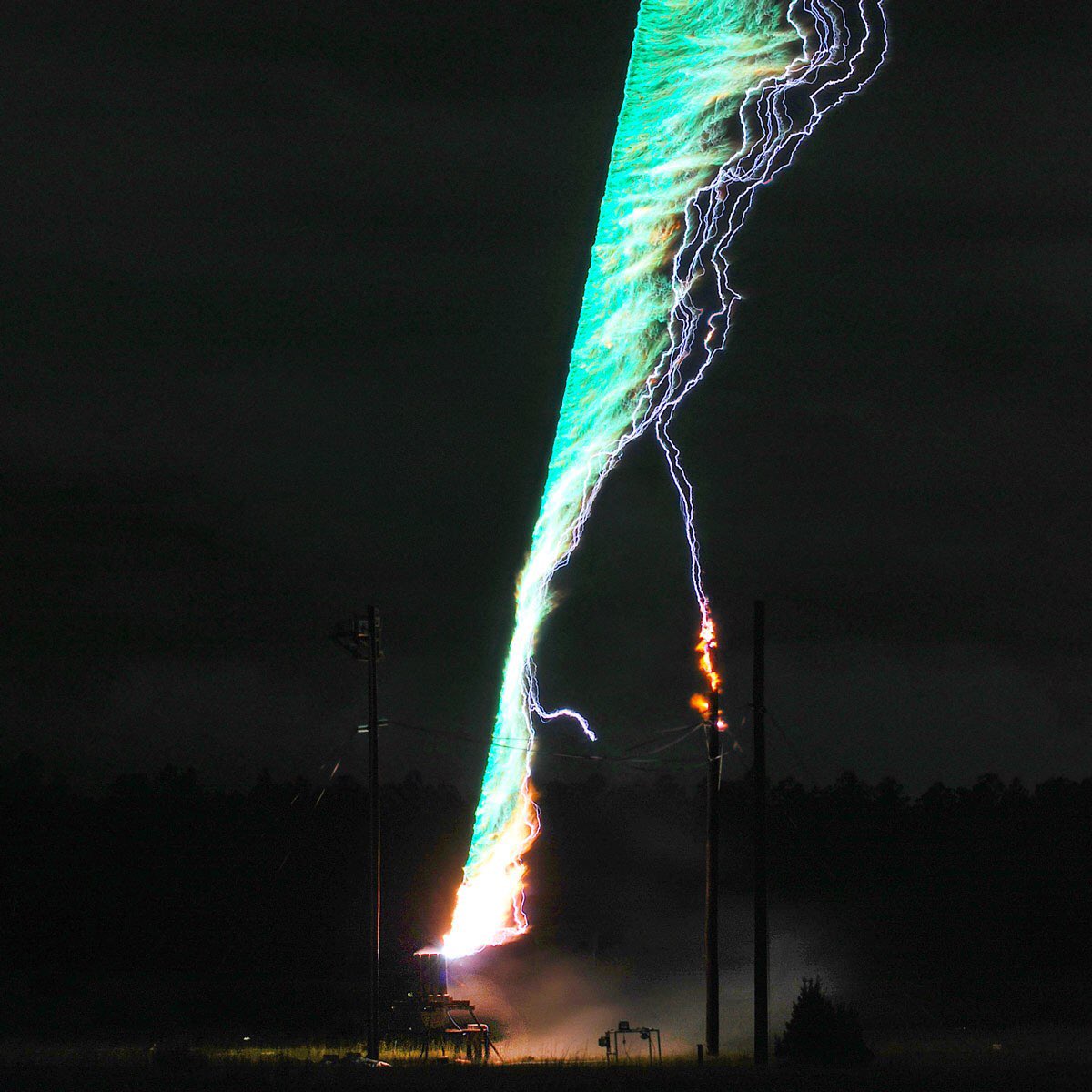

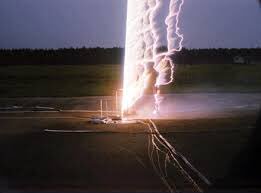

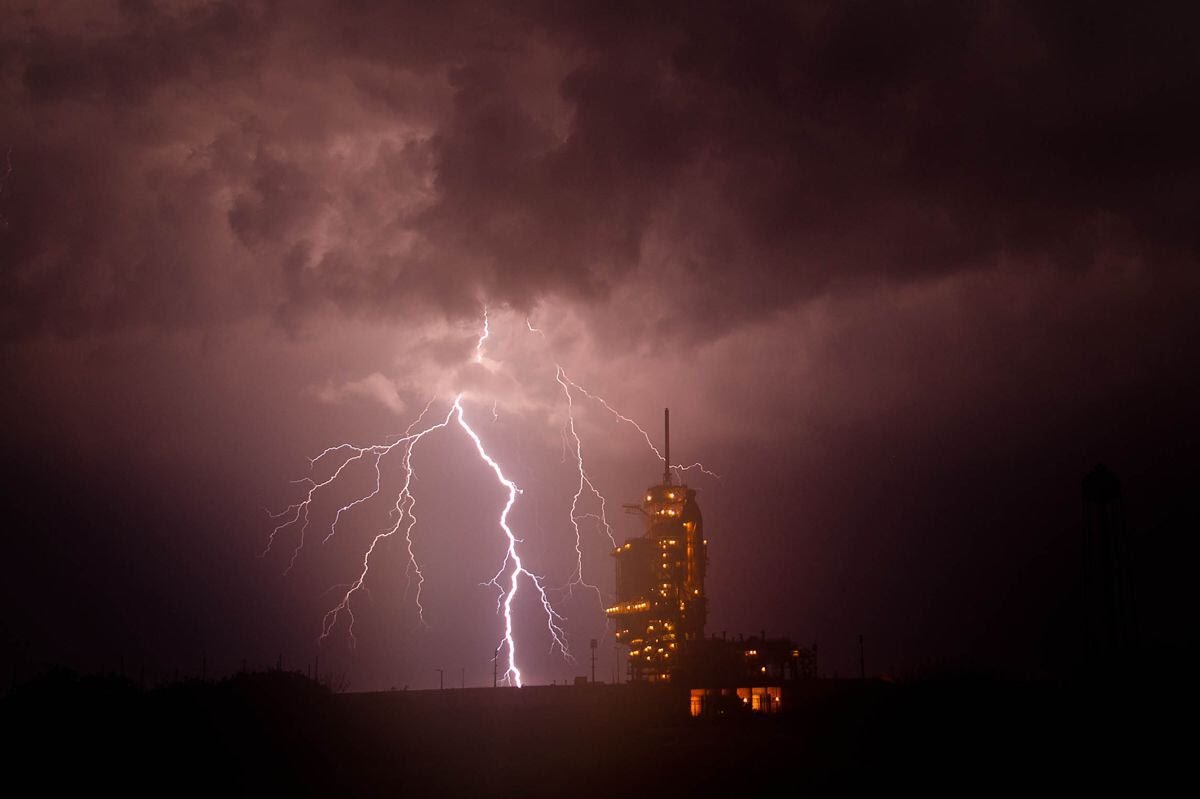
 xkcd" title="It’s not shocking (heh) for a rocket to be struck by lightning, and when it happens it should usually be ok.But it’s still extremely cool,m to see, and a nice engineering triumph when the spacecraft survives.https://abs.twimg.com/emoji/v2/... draggable="false" alt="📷" title="Camera" aria-label="Emoji: Camera"> xkcd" class="img-responsive" style="max-width:100%;"/>
xkcd" title="It’s not shocking (heh) for a rocket to be struck by lightning, and when it happens it should usually be ok.But it’s still extremely cool,m to see, and a nice engineering triumph when the spacecraft survives.https://abs.twimg.com/emoji/v2/... draggable="false" alt="📷" title="Camera" aria-label="Emoji: Camera"> xkcd" class="img-responsive" style="max-width:100%;"/>
